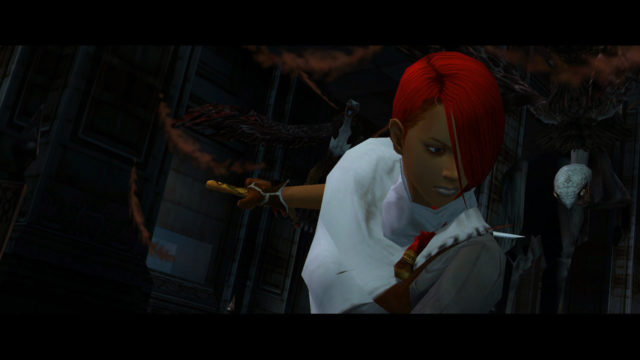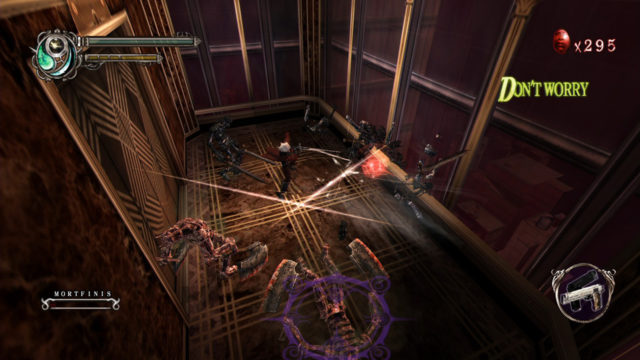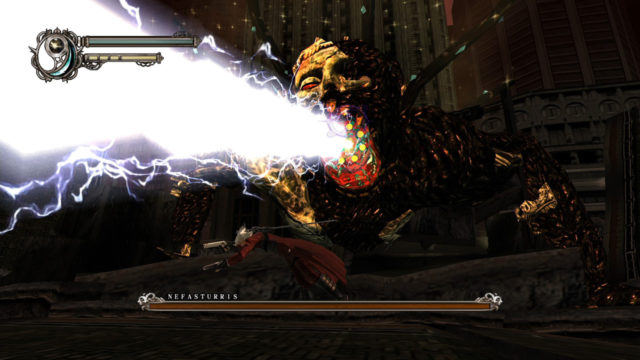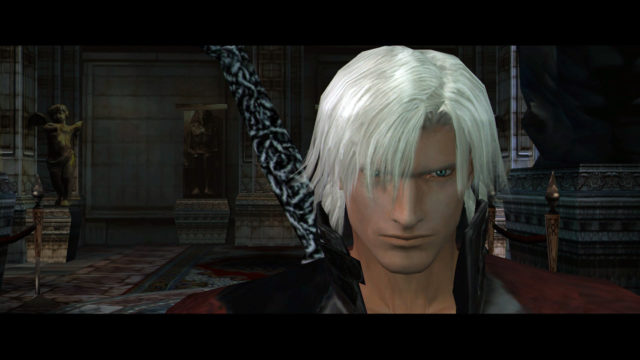Combat can be fun on higher difficulties; good post-game content; runs really well, especially the animations; some cool boss fights
A boring story told poorly; fewer combat options compared to the rest of genre; dull aesthetics; default difficulty too easy; frustrating camera
Like many gamers, I enjoy revisiting some older games I love from time to time; the constant flow of ports, remasters, and remakes on Switch certainly helps make this process easier. However, something I don’t often get the chance, or have the desire, to do is take a second glance at games I reviled. This is what makes reviewing Capcom’s Devil May Cry 2 such an interesting opportunity. The sequel received middling reviews upon its release in 2003, but it’s the franchise fans that really derided the game, marking it the black sheep for all the ways in which it failed to live up to its genre defining predecessor- and I was one of those fans. Now, 16 years have passed and I can examine the game without the burden of expectation, so let’s take a look.
Right off the bat, Devil May Cry 2 offers two playable characters: the returning hero Dante and a new femme fatale, Lucia. Most players will likely feel compelled to jump back into Dante’s stylish boots but that’s really a mistake, because doing so will present you with a nearly incomprehensible story. There’s enough there to figure out the general gist, but the bulk of it only comes through clearly through Lucia’s storyline, and she really is much more of a driving force while Dante is really just giving a helping hand. Granted, playing as the newer character doesn’t turn the plot into a masterpiece, as what’s there still isn’t particularly creative, interesting, or even told all that well.
So, what’s happening? Lucia and her mother are seemingly all that remain of a group pledged to defend their island home from demonic forces. Long ago, the clan fought alongside Sparda, Dante’s benevolent demon father, to defeat an evil demon that might soon be coming back. Arius, the head of a massive corporation, has used evil magic to boost his power and success but now he seeks that demonic power to grant him the strength to control the world, so Lucia and Dante have to team up to stop him. Played together, the two campaigns make for a coherent story, but overall, it’s pretty bland with surprisingly little going on in terms of writing or voice acting.

This form of storytelling is one of the most notable backward slides for the series. Devil May Cry wasn’t exactly worthy of awards, but Dante’s brash attitude and flippant dialogue in the face of horrific monsters gave the game a bit of zest that DMC 2 is sorely lacking. In fact, one might be forgiven for assuming Dante is a silent protagonist as he is shockingly quiet throughout much of the game, only uttering one or two lines in most cutscenes. Near the end, he throws out a few one liners and Arius turns into a cartoon villain, but everything in the first two acts is relegated to somber exposition. Lucia at least has some moderately dramatic material to work with, but her strange accent (Italian? Spanish?) is definitely distracting.
But let’s be honest, this isn’t the sort of game we play for the story, it’s all about the gameplay! That said, once again, we notice another significant step back. The first game pretty much defined the fast paced, combo-driven action gameplay that would define two generations worth of action games, and that approach is still plenty evident, albeit in quite a watered-down approach. Instead of receiving a plethora of melee and ranged weapons with numerous moves that can be unlocked via Red Orbs earned through skilled gameplay, DMC 2 presents a much more limited set of options. Dante and Lucia do play quite differently as they each feature unique weapons, however their primary weapon is limited to only a single type: normal swords for Dante and smaller, dual-swords for Lucia. You can find new swords for both, but they only offer slight changes to things like speed and range instead of different play styles. Thankfully, there is a broader and more meaningful selection of ranged weapons, but the real disappointment is the upgrade system for all the weapons, which only boosts attack power instead of unlocking new skills.
These limitations certainly hurt combat, but that doesn’t necessarily mean it’s terrible, which is important because the focus still remains on fighting. The good news is that Dante and Lucia do feel substantially different, even if their basic move sets use the same button inputs that all serve the same basic purpose. Dante is a little slower and hits harder, while Lucia is faster but a little weaker; thankfully this doesn’t mean that Dante feels like a sloth or that Lucia’s hits are too weak. If anything, the ranged weapons feel like they received more of a focus, which is both good and bad. Dante’s arsenal, of course, includes his twin pistols, but he also gets a shotgun, a submachine gun, and even a rocket launcher while Lucia has a couple varieties of throwing knives, an underwater dart-gun, and even grenades. Yes, I did say underwater, and yes, those levels are annoying. All of these really do feel like they have a unique purpose in combat; the ability for Dante’s shotgun to defeat larger enemies is especially satisfying, but they ultimately feel overpowered. Too often the best, and in the case of some bosses, only, response to some enemies is to just sit back and lay into them with your guns or knives. A more diverse array of melee weapons or at least a constantly expanding move set would have definitely made close range combat a lot more compelling.

Going through the levels also feels like a bit of a chore, as well, as they are wildly inconsistent in terms of setting, pacing, and overall design. Some levels are quite long as you work your way through maze-like settings filled with lots of fights and a few simple puzzles before culminating in a boss fight. The next level might just be a boss fight. The next, maybe one room with a few enemies and then another boss fight. Where you go also feels random as one stage has you fighting through city streets and the next puts you into an underground bunker that apparently leads to an oil rig in the ocean. It certainly doesn’t help that many areas, and even entire levels, are copied and pasted between Dante and Lucia’s campaigns. One series of events in Dante’s campaign has him meeting with Lucia after recovering a relic in an ancient ruin before then going back to meet with Lucia’s mother who tells him Lucia has gone to confront the big bad guy so Dante needs to go after her, and then you’re pretty much immediately there for your first fight with Arius. The end result is just a really inconsistent flow which is never good for a game ostensibly built on the momentum of fast-paced action.
As you may have gathered, boss fights are a pretty significant part of the game and thankfully this is where things fare a little better. First, it should be mentioned that there is a bit of repetition as a few foes show up multiple times in a single campaign as well as also being in both campaigns, which is a minor nuisance. However, most of the bigger baddies are at least fairly creative in design and a few present some enjoyable combat experiences with a variety of attacks and multiple stages that reward your ability to recognize patterns and react quickly. Of course, some are better than others, as one particularly annoying one that shows up near the end of the game isn’t entirely consistent in terms of when he actually takes damage and the only way to hurt him, as well as a few more bosses, is with ranged attacks which is just inherently less fun. The other good thing about some of these bosses is that they actually present a challenge compared to everything else.
One of the game’s most shocking twists is how easy it is. The first game was difficult by default but gave you a chance to make things easier upon too many deaths, whereas this game is just super simple from the start and it only spikes a bit during a few of the boss fights. Most foes are surprisingly unmotivated to fight back and their overall aggression only increases a smidge as you progress. Thankfully, there’s a hard mode that is unlocked upon beating both campaigns that immediately makes the baddies a bigger threat, including whole new attacks even from the most basic enemies on the first level; this difficulty probably should have been the default with maybe a couple bosses re-balanced. However, completing both campaigns once isn’t exactly the most exhilarating experience, so I’m not sure how motivated the average gamer will be to stick around.

At least the good news is that if you do decide to keep playing, you’ll probably finally get to have quite a bit more fun. Each campaign is fairly short, about 3-4 hours for Dante and 2-3 for Lucia, which isn’t great, but the fact that the real normal difficulty is finally unlocked indicates the developers’ efforts in terms of replayability. Aside from the hard difficulty, you also get to play the Bloody Palace, a waves-based endurance test as you face tougher and tougher foes with each level. This is probably the most fun I had with the game because the combat system, as limited as it is compared to its predecessor, still works perfectly fine when presented with an interesting array of challenging enemies. Continuing to delve into the campaign will net you another playable character in addition to an even tougher difficulty, but at this point one must still ask who has the patience to keep going?
Really, another major demotivating force is the overall look of the game. While the character models look pretty good, including this very Dolph Lundgren looking take on Dante, and feature animations that legitimately hold up today, the world is incredibly dull. The Gothic castle of the first game has been swapped out with large, simple slabs of brown and gray. First, you’re in a brown village, then a brown cave, then a gray city, then a gray warehouse, and so on. Occasionally, the game delves into some interesting locales, such as the veiny, infected looking influence of the demon world as it starts to merge with our reality, or the grandiose, detailed marble tiles that stretch from floor to ceiling in Aurius’ skyscraper, but these are mere diversions. And then there’s the camera, which is often inoffensive, and sometimes even effective, but often it assumes an angle far too close for the action, even in larger environments. Yes, I know these sorts of fixed cameras were par for the course in the early 2000s, but you’ll quickly grow tired of standing around, dominating the frame, as you repeatedly fire your guns at flying foes somewhere far away from your screen. Often, you might as well be fighting the enemy health bar in the corner instead of the demon itself.

This isn’t really a knock against the game itself, but I do find it somewhat humorous how the pre-rendered cutscenes from games of this era that used to be show-stoppingly beautifully now look absolutely muddled. While those once expensive CGI graphics remain stuck in whatever resolution they were originally saved as, the rest of the game’s textures are crisp and clear thanks to the HD remaster, and everything runs at a fast, smooth framerate.
Lastly, the sound design is merely okay. As mentioned earlier, the dialogue is surprisingly sparse and not particularly merit-worthy when it shows up, but nothing else really stands out as exceptional. The guns sound decent, but the frequency with which they’re used, along with Lucia’s various grunts, will likely become annoying before too long. The music is uninteresting as well, always adopting a brooding atmospheric tone outside of combat and then switching to grinding industrial metal when the fighting begins. It’s fairly standard for the series but a memorable melody or recognizable character theme would have been nice every once and a while.
Long ago, I remember my friends and I coming to a unanimous conclusion- Devil May Cry 2 did not exist. We joked about how it was strange Capcom decided to skip a second game before launching the much beloved Devil May Cry 3. Playing it now, perhaps that level of outright dismissal was a little overwrought, because standing on its own, DMC 2 is just kind of a middling action game that only becomes interesting after trudging through a largely boring campaign, and even then its limited combat options made it inferior to many other games, including its direct predecessor. So, in 2019, it’s just kind of a serviceable action game for people willing to put in the time. That being said, we have to acknowledge the reality of the situation: Capcom has remastered the whole franchise for other current generation hardware and, judging from the fact that DMC was already released for Switch, it only makes sense they’ll keep bringing the others to Switch as well. Beyond that, we also have options like Bayonetta, Bayonetta 2, and Astral Chain when it comes to really good, stylish action games. In short, f you’re absolutely desperate for more demonic combat and can’t wait for the all-but-inevitable release of the far superior Devil May Cry 3, then I suppose there are worse options than giving this disappointing sequel a try.
Nintendojo was provided a copy of this game for review by a third party, though that does not affect our recommendation. For every review, Nintendojo uses a standard criteria.




 ShareThis
ShareThis





